
Catalog excerpts
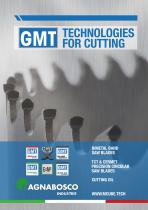
BLACK MAMBA BIMETAL BAND SAW BLADES TCT & CERMET PRECISION CIRCULAR SAW BLADES CUTTING OIL
Open the catalog to page 1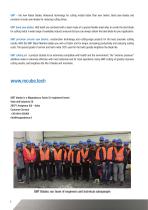
GMT – the new Italian blades. Advanced technology for cutting metals faster than ever before. Band saw blades and precision circular saw blades for reducing cutting times. GMT band saw blades: HSS teeth are combined with a back made of a special flexible steel alloy to create the best blade for cutting metal. A wide range of available products ensures that you can always obtain the ideal blade for your application. GMT precision circular saw blades:: construction technology and cutting-edge projects for the best precision cutting results. With the GMT Black Mamba blades you will cut faster...
Open the catalog to page 2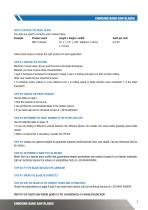
CHOOSING BAND SAW BLADES HOW TO CHOOSE THE RIGHT BLADE The data you need to correctly order a blade follow Example Product name Length x height x width GMT X Ultra® 16’ x 1-1/4” x .042” 4860mm x 34mm x 1.07mm Follow these steps to choose the right product for each application: STEP #1: ANALYSE THE CUTTING Machine: in most cases, all you need to know is the blade dimensions Material: you have to know these characteristics: • type • hardness (if tempered or hardened) • shape • size • if cutting one piece at a time or stack cutting Other user needs that are important to know: • if continual,...
Open the catalog to page 3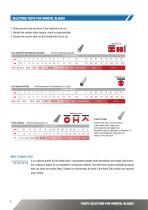
SELECTING TEETH FOR BIMETAL BLADES 1. Determine the size and form of the material to be cut 2. Identify the relative table (square, round or pipes/profiles) 3. Choose the correct pitch for the section/form to be cut Find the cutting thickness (W) 6/8 5/8 4/6 3/4 2/3 1.5/2.0 1.4/2.0 CUTTING THICKNESS FULL SQUARE OR RECTANGULAR SECTIONS DENTI - TPI 14/18 10/14 8/12 6/10 Trovate lo spessore di taglio (W) SEZIONI QUADRATE O RETTANGOLARI PIENE Trovate il diametro del materiale da tagliare (D) SEZIONI TONDE PIENE DIAMETRO DI TAGLIO POLLICI MM FULL ROUND SECTIONS Find the diameter of the material...
Open the catalog to page 4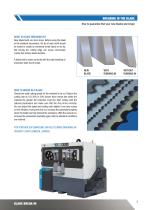
BREAKING IN THE BLADE How to guarantee that your new blades last longer WHAT IS BLADE BREAKING IN? New blade teeth are razor sharp. Before using the blade at the standard parameters, the tip of each tooth should be honed to create an extremely small radius on its tip. Not honing the cutting edge can cause microscopic cracks that reduce blade duration. A blade that is honed correctly with the right breaking-in procedure lasts much longer. HOW TO BREAK IN A BLADE Choose the right cutting speed for the material to be cut. Reduce the cutting rate so it is 20% to 50% slower than normal (the...
Open the catalog to page 5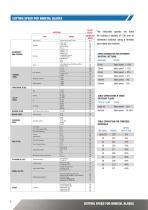
CUTTING SPEED FOR BIMETAL BLADES BLADE SPEED MATERIAL GRADE Steel alloy with chrome MOULD STEEL Mould steel STAINLESS STEEL Stainless steel Nickel-based alloys Inconel® 600, Inconel® 718, Nimonic 90, NI-S PAN-C 902, RENE 41 Inconel® 625 Hastalloy B,Waspalloy Nimonic 75, RENE 88 Cast iron TYPE Aluminium Copper CARBON STEEL Medium tenore High tenore The indicated speeds are ideal for cutting a section of 100 mm of untreated material using a bimetal saw blade and coolant. SPEED CORRECTION FOR DIFFERENT MATERIAL SECTIONS: MATERIAL ALLOY STEEL BEARING STEEL Low alloy For water quenching For cold...
Open the catalog to page 6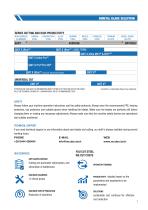
BIMETAL BLADE SELECTION SERIES CUTTING AND HIGH PRODUCTIVITY NON-FERROUS ALUMINIUM CARBON STEEL CONSTRUCTION STEEL ALLOY STEEL BEARING STEEL MOULD STEEL STAINLESS STEEL TITANIUM ALLOYS NICKEL-BASED ALLOYS GMT X UltraTM LONG-TERM GMT X Ultra M51® & M71TM GMT X Ultra ProTM GMT X Pro® Pro HS® GMT X UltraTM Long Life. Extremely Versatile ATTENTION: WE CAN GIVE YOU INFORMATION ABOUT OTHER CUTS THAT ARE NOT IN THIS TABLE. CALL THE TECHNICAL SERVICE AT +390444450404, OR GO TO WWW.MCUBE.TECH Inconel® is a Huntington Alloys Corp. trademark SAFETY Always follow your machine operation instructions and...
Open the catalog to page 7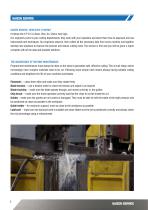
KAIZEN SERVICE KAIZEN SERVICE: HOW DOES IT WORK? It follows the S P D C A (Scan, Plan, Do, Check, Act) logic. Our engineers come to your cutting departments, they work with your operators and teach them how to approach and use instruments and techniques. Our engineers observe, then collect all the necessary data from every machine and together develop new solutions to improve the process and reduce cutting costs. The service is free and you will be given a report complete with all the data and possible solutions. THE ADVANTAGES OF ROUTINE MAINTENANCE Programmed maintenance must always be...
Open the catalog to page 8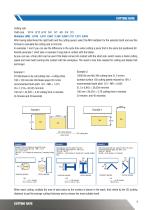
CUTTING RATE Cutting rate Tooth size 10/14 8/12 6/10 5/8 5/7 4/6 3/4 2/3 Multiplier (MR) 4,016 3,341 2,667 2,160 2,058 1,721 1,215 0,843 After having determined the right teeth and the cutting speed, select the MR multiplier for the selected tooth and use this formula to calculate the cutting rate in mm/min. In examples 1 and 2 you can see the difference in the cycle time when cutting a piece that is the same but positioned differently (example 1 short side or example 2 long side in contact with the blade). As you can see, a finer pitch can be used if the blade comes into contact with the...
Open the catalog to page 9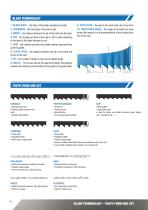
BLADE TERMINOLOGY BLADE TERMINOLOGY 1. BLADE BACK - the body of the blade excluding the teeth. 9. TOOTH FACE - the part of the tooth where the chips form. 10. TOOTH angle of on thewhich tooth face mea8. TOOTH FACERAKE - The ANGLE surface -ofthe the tooth the chip THICKNESS the body dimension sidenot to side. 1.2.BLADE BACK - -The of thefrom blade including tooth portion. 3. WIDTH - the distance between the tip of the tooth and the back. BLADE TERMINOLOGY BLADE TERMINOLOGY BLADE BLADE TERMINOLOGY TERMINOLOGY 2. THICKNESS - The dimension from side to side on the blade. sured with respect to a...
Open the catalog to page 10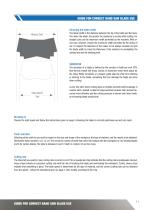
GUIDE FOR CORRECT BAND SAW BLADE USE Choosing the blade width The blade width is the distance between the tip of the tooth and the back. The wider the blade, the greater its resistance to arcing while cutting. For straight cuts use the maximum width permitted by the machine. With arced cuts, however, choose the maximum width permitted by the radius of cut. To respect the tolerance of the radius of cut always consider not just the blade width but also the thickness of the material, its workability, the cutting rate and the starting point. SERRATION The serration of a blade is defined by the...
Open the catalog to page 11
